KIA NIRO HYBRID EV 2022 Repair Manual
Manufacturer: KIA, Model Year: 2022, Model line: NIRO HYBRID EV, Model: KIA NIRO HYBRID EV 2022Pages: 684, PDF Size: 9.67 MB
Page 61 of 684
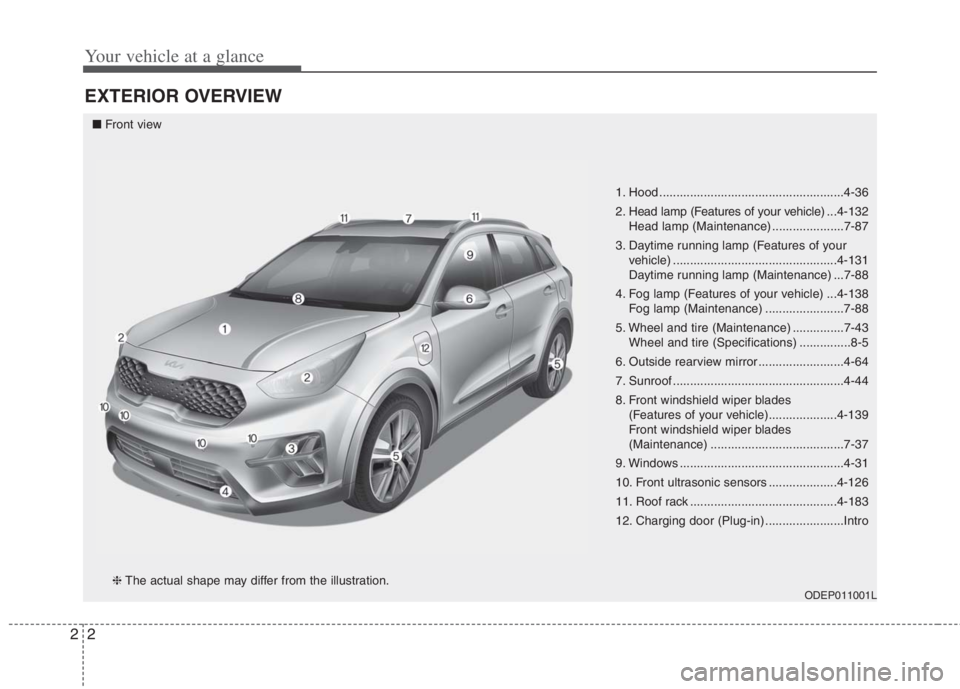
Your vehicle at a glance
2 2
EXTERIOR OVERVIEW
1. Hood ......................................................4-36
2. Head lamp (Features of your vehicle) ...4-132
Head lamp (Maintenance) .....................7-87
3. Daytime running lamp (Features of your
vehicle) ................................................4-131
Daytime running lamp (Maintenance) ...7-88
4. Fog lamp (Features of your vehicle) ...4-138
Fog lamp (Maintenance) .......................7-88
5. Wheel and tire (Maintenance) ...............7-43
Wheel and tire (Specifications) ...............8-5
6. Outside rearview mirror .........................4-64
7. Sunroof ..................................................4-44
8. Front windshield wiper blades
(Features of your vehicle)....................4-139
Front windshield wiper blades
(Maintenance) .......................................7-37
9. Windows ................................................4-31
10. Front ultrasonic sensors ....................4-126
11. Roof rack ...........................................4-183
12. Charging door (Plug-in) .......................Intro
ODEP011001L
■Front view
❈The actual shape may differ from the illustration.
Page 62 of 684
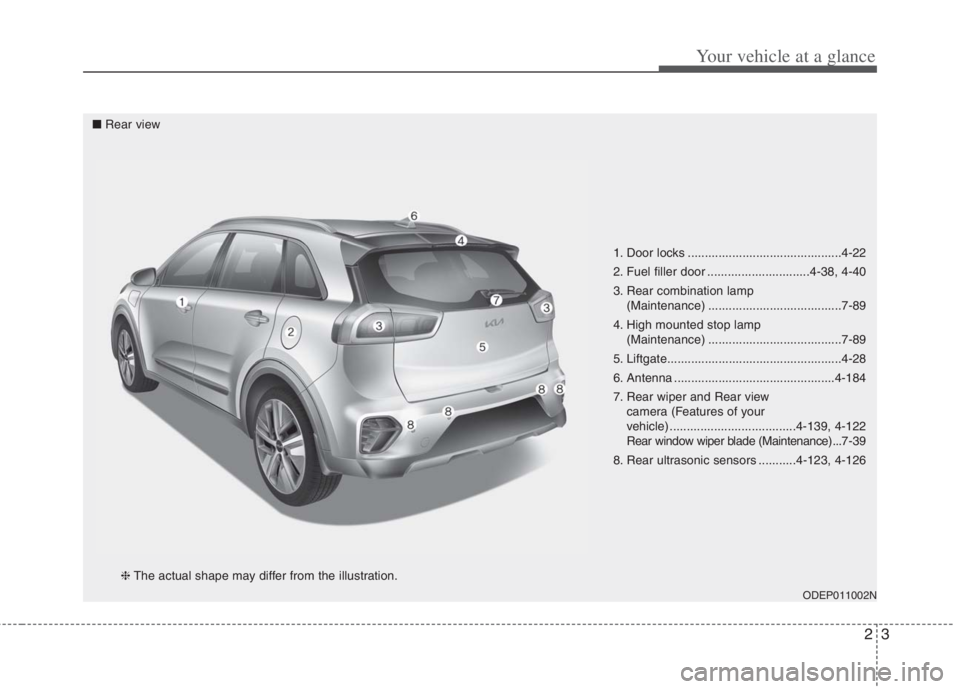
23
Your vehicle at a glance
1. Door locks .............................................4-22
2. Fuel filler door ..............................4-38, 4-40
3. Rear combination lamp
(Maintenance) .......................................7-89
4. High mounted stop lamp
(Maintenance) .......................................7-89
5. Liftgate...................................................4-28
6. Antenna ...............................................4-184
7. Rear wiper and Rear view
camera (Features of your
vehicle) .....................................4-139, 4-122
Rear window wiper blade (Maintenance) ...7-39
8. Rear ultrasonic sensors ...........4-123, 4-126
ODEP011002N
■Rear view
❈The actual shape may differ from the illustration.
Page 63 of 684
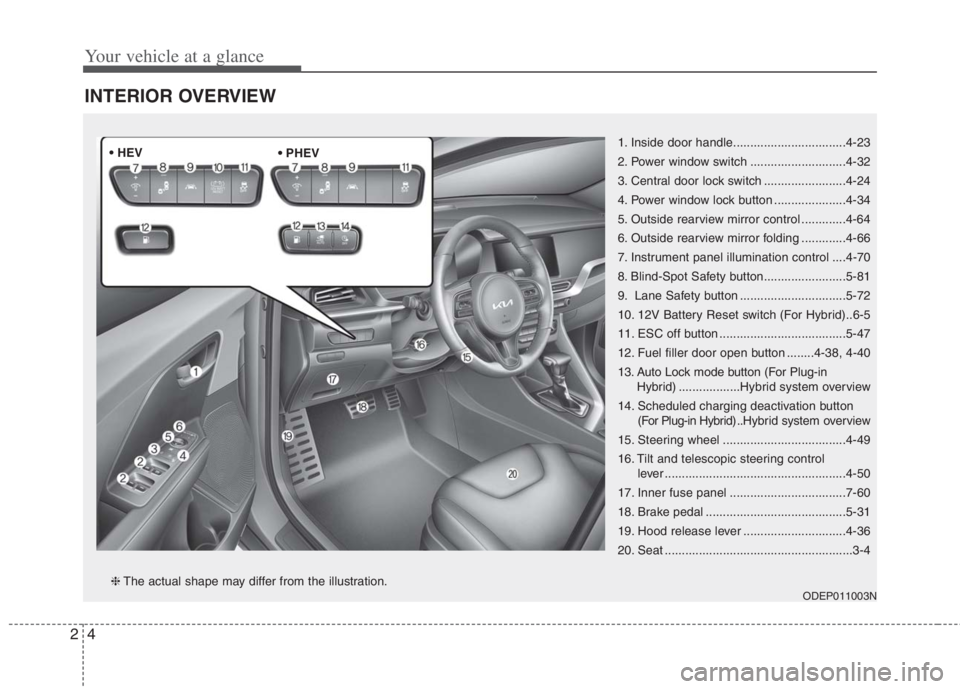
Your vehicle at a glance
4 2
INTERIOR OVERVIEW
1. Inside door handle.................................4-23
2. Power window switch ............................4-32
3. Central door lock switch ........................4-24
4. Power window lock button .....................4-34
5. Outside rearview mirror control .............4-64
6. Outside rearview mirror folding .............4-66
7. Instrument panel illumination control ....4-70
8. Blind-Spot Safety button........................5-81
9. Lane Safety button ...............................5-72
10. 12V Battery Reset switch (For Hybrid)..6-5
11. ESC off button .....................................5-47
12. Fuel filler door open button ........4-38, 4-40
13. Auto Lock mode button (For Plug-in
Hybrid)..................Hybrid system overview
14. Scheduled charging deactivation button
(For Plug-in Hybrid) ..Hybrid system overview
15. Steering wheel ....................................4-49
16. Tilt and telescopic steering control
lever .....................................................4-50
17. Inner fuse panel ..................................7-60
18. Brake pedal .........................................5-31
19. Hood release lever ..............................4-36
20. Seat .......................................................3-4
ODEP011003N❈The actual shape may differ from the illustration. • HEV
Page 64 of 684
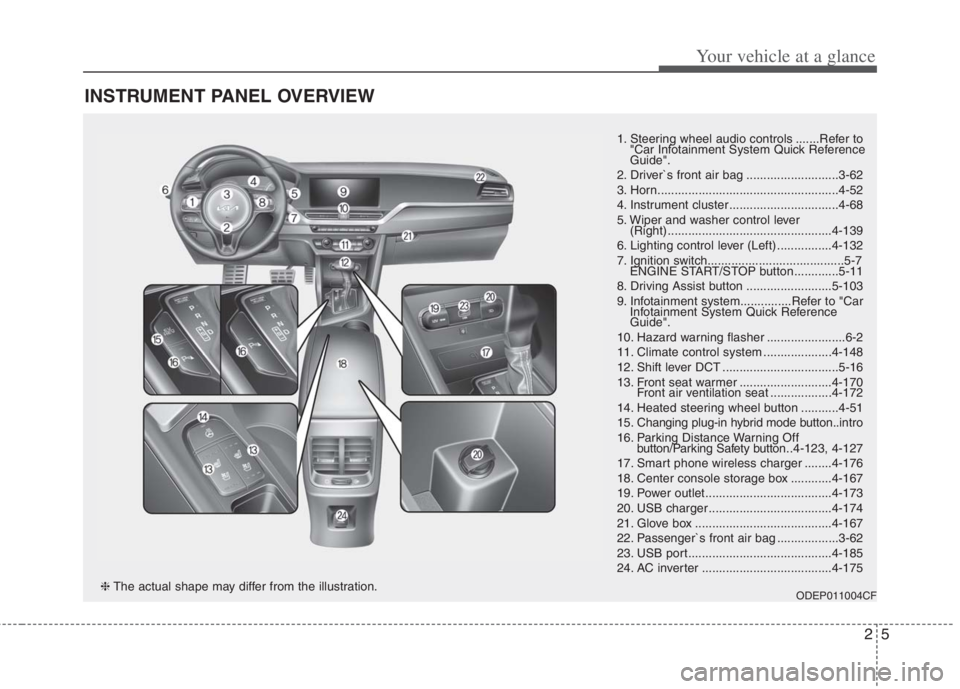
25
Your vehicle at a glance
INSTRUMENT PANEL OVERVIEW
1. Steering wheel audio controls .......Refer to
"Car Infotainment System Quick Reference
Guide".
2. Driver`s front air bag ...........................3-62
3. Horn.....................................................4-52
4. Instrument cluster ................................4-68
5. Wiper and washer control lever
(Right) ................................................4-139
6. Lighting control lever (Left) ................4-132
7. Ignition switch........................................5-7
ENGINE START/STOP button .............5-11
8. Driving Assist button .........................5-103
9. Infotainment system...............Refer to "Car
Infotainment System Quick Reference
Guide".
10. Hazard warning flasher .......................6-2
11. Climate control system ....................4-148
12. Shift lever DCT ..................................5-16
13. Front seat warmer ...........................4-170
Front air ventilation seat ..................4-172
14. Heated steering wheel button ...........4-51
15. Changing plug-in hybrid mode button..intro
16. Parking Distance Warning Off
button/Parking Safety button..4-123, 4-127
17. Smart phone wireless charger ........4-176
18. Center console storage box ............4-167
19. Power outlet.....................................4-173
20. USB charger ....................................4-174
21. Glove box ........................................4-167
22. Passenger`s front air bag ..................3-62
23. USB port..........................................4-185
24. AC inverter ......................................4-175
ODEP011004CF❈The actual shape may differ from the illustration.
Page 65 of 684
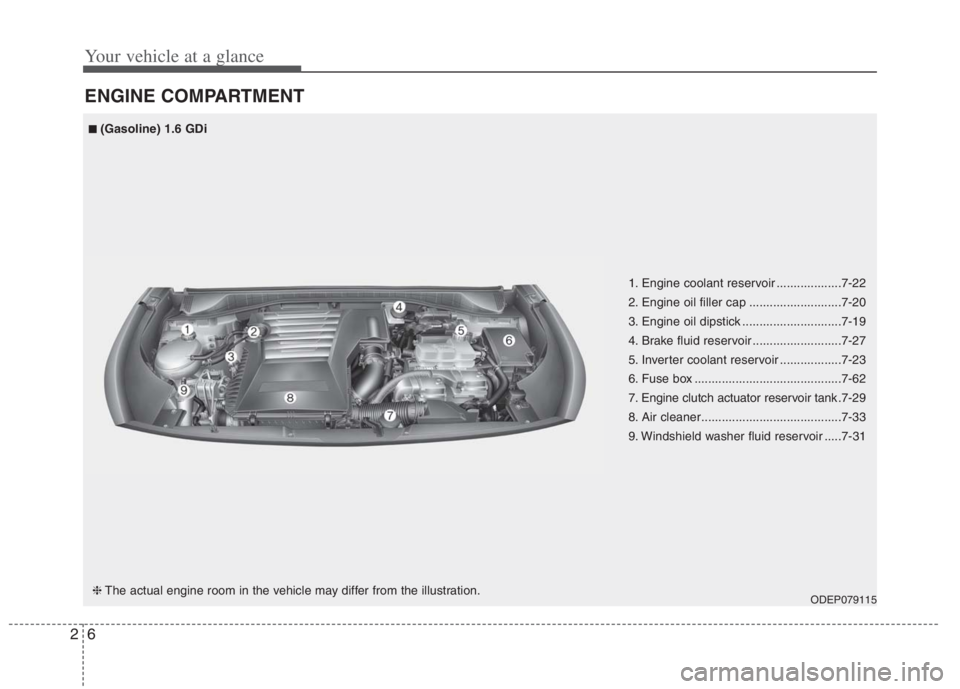
Your vehicle at a glance
6 2
ENGINE COMPARTMENT
ODEP079115
■
■(Gasoline) 1.6 GDi
❈The actual engine room in the vehicle may differ from the illustration.1. Engine coolant reservoir ...................7-22
2. Engine oil filler cap ...........................7-20
3. Engine oil dipstick .............................7-19
4. Brake fluid reservoir ..........................7-27
5. Inverter coolant reservoir ..................7-23
6. Fuse box ...........................................7-62
7. Engine clutch actuator reservoir tank.7-29
8. Air cleaner.........................................7-33
9. Windshield washer fluid reservoir .....7-31
Page 66 of 684
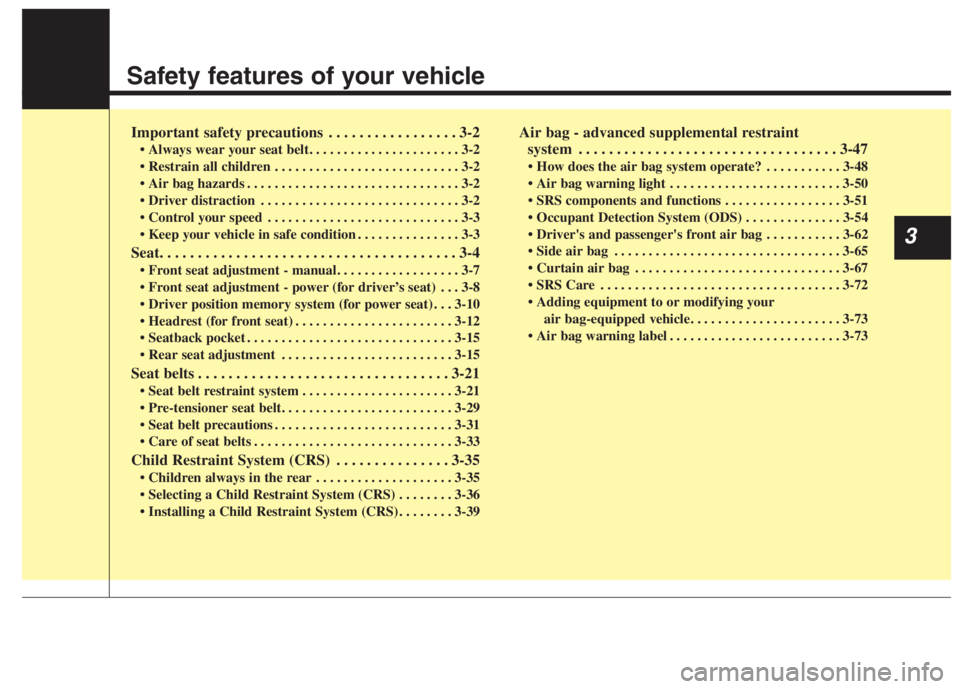
Safety features of your vehicle
Important safety precautions . . . . . . . . . . . . . . . . . 3-2
• Always wear your seat belt. . . . . . . . . . . . . . . . . . . . . . 3-2
. . . . . . . . . . . . . . . . . . . . . . . . . . . 3-2
. . . . . . . . . . . . . . . . . . . . . . . . . . . . . . . 3-2
. . . . . . . . . . . . . . . . . . . . . . . . . . . . . 3-2
. . . . . . . . . . . . . . . . . . . . . . . . . . . . 3-3
. . . . . . . . . . . . . . . 3-3
Seat. . . . . . . . . . . . . . . . . . . . . . . . . . . . . . . . . . . . . . . 3-4
. . . 3-8
. . . 3-10
. . . . . . . . . . . . . . . . . . . . . . . 3-12
. . . . . . . . . . . . . . . . . . . . . . . . . . . . . . 3-15
. . . . . . . . . . . . . . . . . . . . . . . . . 3-15
Seat belts . . . . . . . . . . . . . . . . . . . . . . . . . . . . . . . . . 3-21
. . . . . . . . . . . . . . . . . . . . . . 3-21
. . . . . . . . . . . . . . . . . . . . . . . . . . 3-31
. . . . . . . . . . . . . . . . . . . . . . . . . . . . . 3-33
Child Restraint System (CRS) . . . . . . . . . . . . . . . 3-35
. . . . . . . . . . . . . . . . . . . . 3-35
. . . . . . . . 3-39
Air bag - advanced supplemental restraint
system . . . . . . . . . . . . . . . . . . . . . . . . . . . . . . . . . . 3-47
. . . . . . . . . . . 3-48
. . . . . . . . . . . . . . . . . . . . . . . . . 3-50
. . . . . . . . . . . . . . . . . 3-51
. . . . . . . . . . . . . . 3-54
. . . . . . . . . . . 3-62
. . . . . . . . . . . . . . . . . . . . . . . . . . . . . . . . . 3-65
. . . . . . . . . . . . . . . . . . . . . . . . . . . . . . 3-67
. . . . . . . . . . . . . . . . . . . . . . . . . . . . . . . . . . . 3-72
air bag-equipped vehicle. . . . . . . . . . . . . . . . . . . . . . 3-73
. . . . . . . . . . . . . . . . . . . . . . . . . 3-73
3
Page 67 of 684
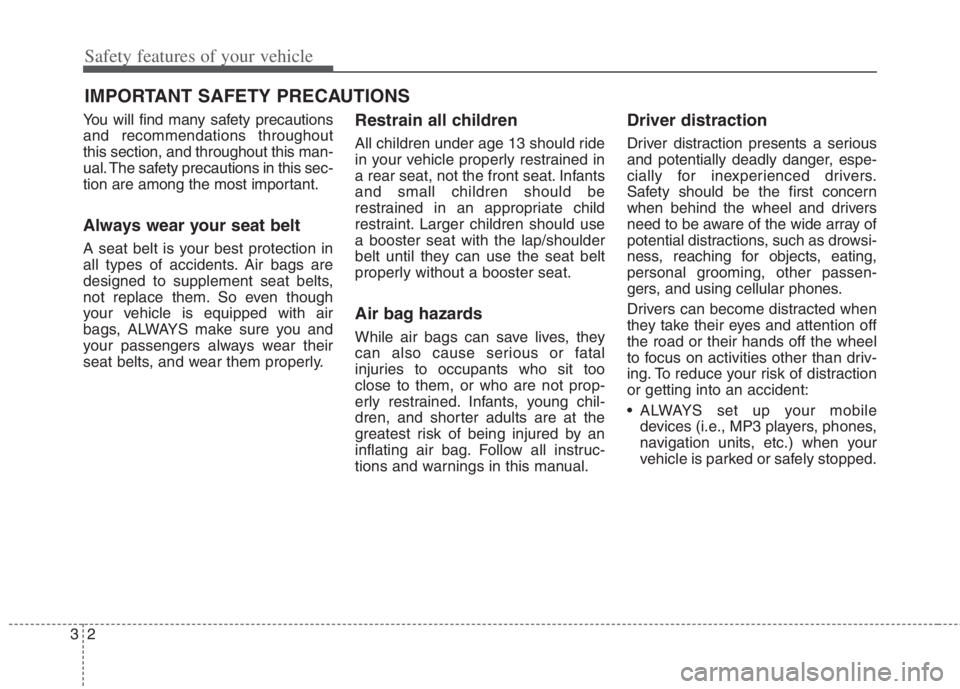
Safety features of your vehicle
2 3
You will find many safety precautions
and recommendations throughout
this section, and throughout this man-
ual. The safety precautions in this sec-
tion are among the most important.
Always wear your seat belt
A seat belt is your best protection in
all types of accidents. Air bags are
designed to supplement seat belts,
not replace them. So even though
your vehicle is equipped with air
bags, ALWAYS make sure you and
your passengers always wear their
seat belts, and wear them properly.
Restrain all children
All children under age 13 should ride
in your vehicle properly restrained in
a rear seat, not the front seat. Infants
and small children should be
restrained in an appropriate child
restraint. Larger children should use
a booster seat with the lap/shoulder
belt until they can use the seat belt
properly without a booster seat.
Air bag hazards
While air bags can save lives, they
can also cause serious or fatal
injuries to occupants who sit too
close to them, or who are not prop-
erly restrained. Infants, young chil-
dren, and shorter adults are at the
greatest risk of being injured by an
inflating air bag. Follow all instruc-
tions and warnings in this manual.
Driver distraction
Driver distraction presents a serious
and potentially deadly danger, espe-
cially for inexperienced drivers.
Safety should be the first concern
when behind the wheel and drivers
need to be aware of the wide array of
potential distractions, such as drowsi-
ness, reaching for objects, eating,
personal grooming, other passen-
gers, and using cellular phones.
Drivers can become distracted when
they take their eyes and attention off
the road or their hands off the wheel
to focus on activities other than driv-
ing. To reduce your risk of distraction
or getting into an accident:
• ALWAYS set up your mobile
devices (i.e., MP3 players, phones,
navigation units, etc.) when your
vehicle is parked or safely stopped.
IMPORTANT SAFETY PRECAUTIONS
Page 68 of 684
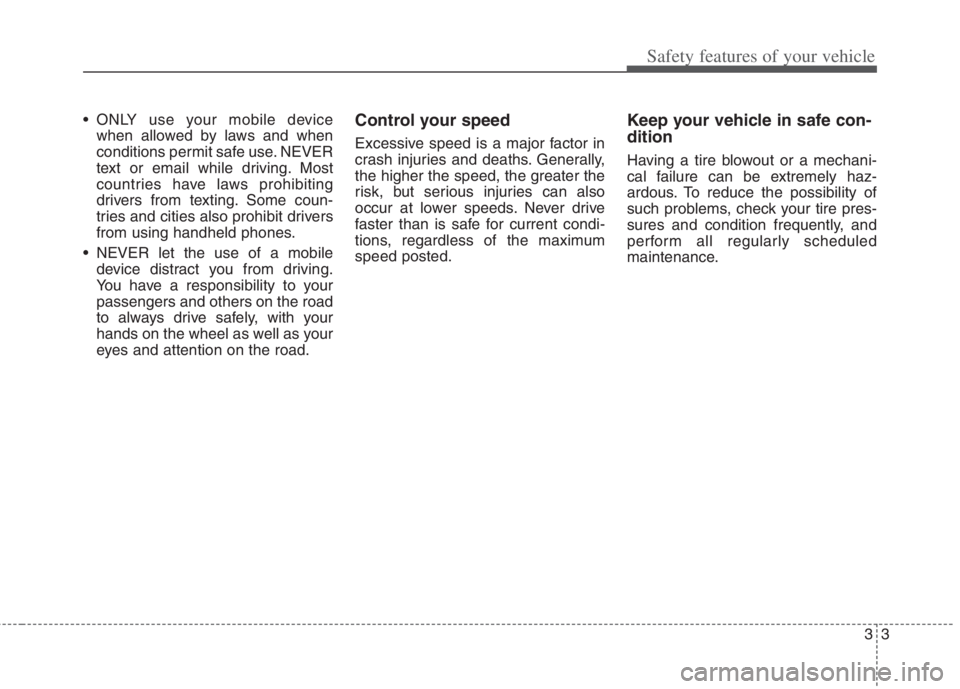
33
Safety features of your vehicle
ONLY use your mobile device
when allowed by laws and when
conditions permit safe use. NEVER
text or email while driving. Most
countries have laws prohibiting
drivers from texting. Some coun-
tries and cities also prohibit drivers
from using handheld phones.
NEVER let the use of a mobile
device distract you from driving.
You have a responsibility to your
passengers and others on the road
to always drive safely, with your
hands on the wheel as well as your
eyes and attention on the road.Control your speed
Excessive speed is a major factor in
crash injuries and deaths. Generally,
the higher the speed, the greater the
risk, but serious injuries can also
occur at lower speeds. Never drive
faster than is safe for current condi-
tions, regardless of the maximum
speed posted.
Keep your vehicle in safe con-
dition
Having a tire blowout or a mechani-
cal failure can be extremely haz-
ardous. To reduce the possibility of
such problems, check your tire pres-
sures and condition frequently, and
perform all regularly scheduled
maintenance.
Page 69 of 684
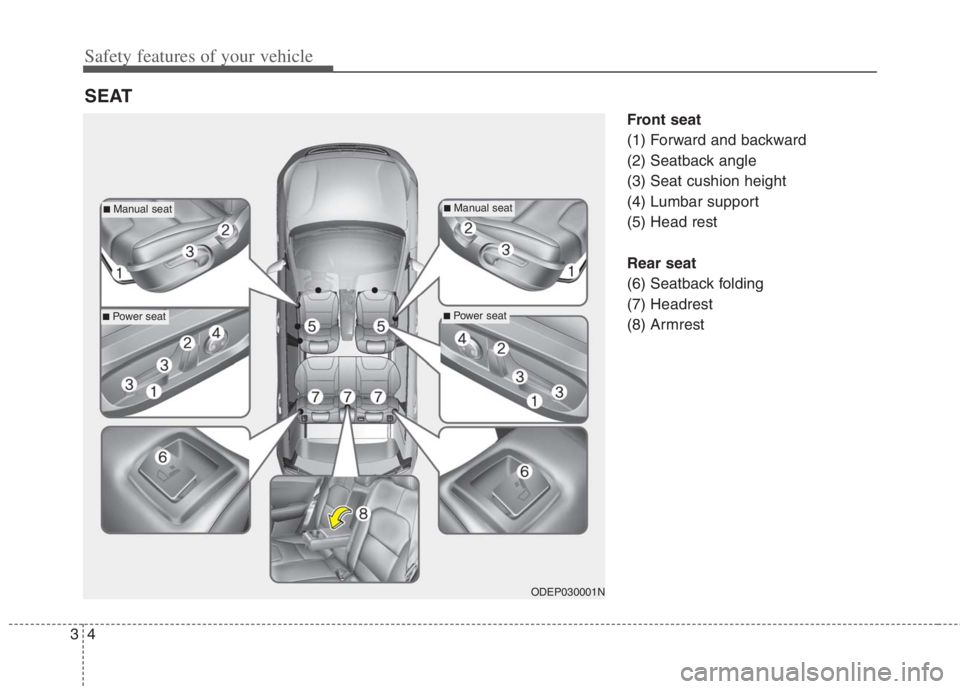
Safety features of your vehicle
4 3
Front seat
(1) Forward and backward
(2) Seatback angle
(3) Seat cushion height
(4) Lumbar support
(5) Head rest
Rear seat
(6) Seatback folding
(7) Headrest
(8) Armrest
SEAT
ODEP030001N
■Manual seat
■Power seat
■Manual seat
■Power seat
Page 70 of 684

35
Safety features of your vehicle
WARNING- Uprighting
seat
Do not press the release lever on
a manual seatback without hold-
ing and controlling the seatback.
The seatback will spring upright,
possibly impacting you or other
passengers.
WARNING- Loose
objects
Do not place anything in the dri-
ver's foot well or under the front
seats. Loose objects in the dri-
ver's foot area could interfere
with the operation of the foot
pedals.WARNING- Driver respon-
sibility for passengers
The driver must advise the pas-
sengers to keep the seatback in
an upright position whenever
the vehicle is in motion. If a seat
is reclined during an accident,
the restraint system's ability to
restrain will be greatly reduced.
1KMN3662
WARNING- Seat cushion
Occupants should never sit on
aftermarket seat cushions or sit-
ting cushions. The passenger's
hips may slide under the lap por-
tion of the seat belt during an
accident or a sudden stop.
WARNING- Driver’s seat
Never attempt to adjust the
seat while the vehicle is mov-
ing. This could result in loss
of control of your vehicle.
Do not allow anything to inter-
fere with the normal position
of the seatback. Storing items
against the seatback could
result in serious or fatal injury
in a sudden stop or collision.
Sit as far back as possible from
the steering wheel while still
maintaining comfortable con-
trol of the your vehicle. A dis-
tance of at least 25 cm (10 in.)
from your chest to the steering
wheel is recommended. Failure
to do so can result in air bag
inflation injuries to the driver.